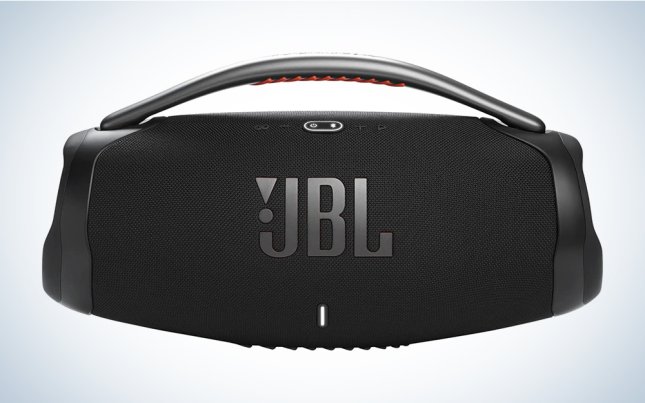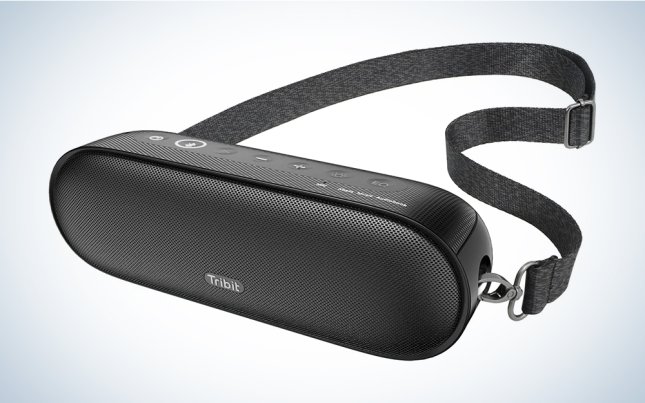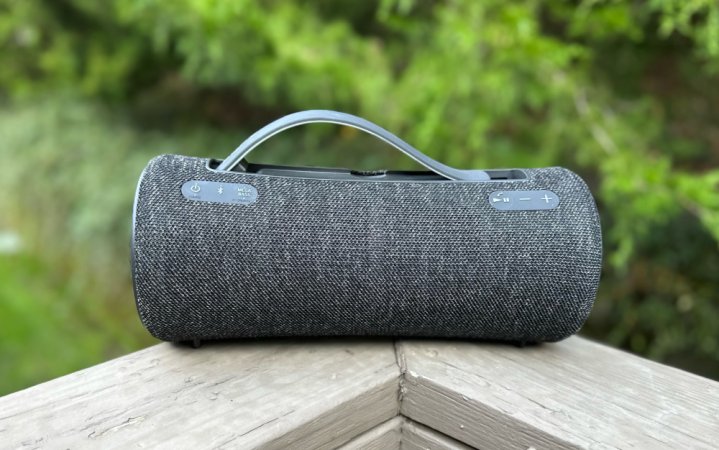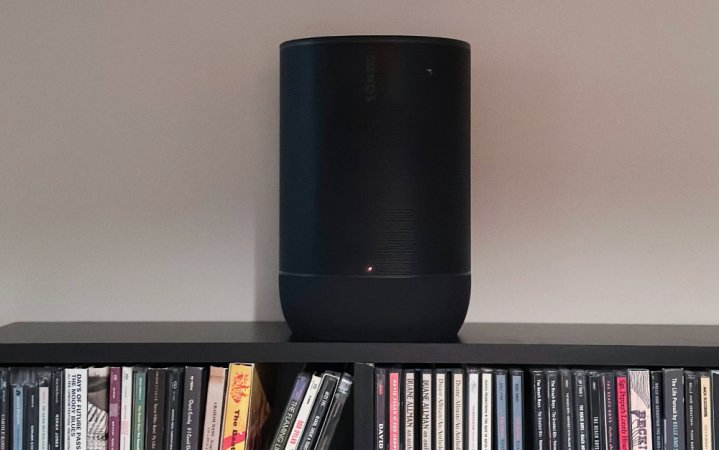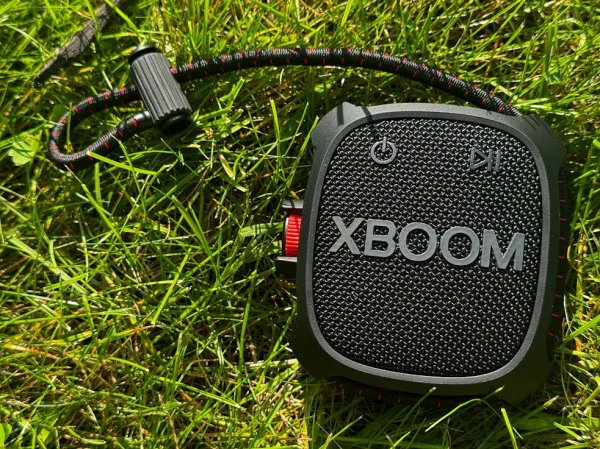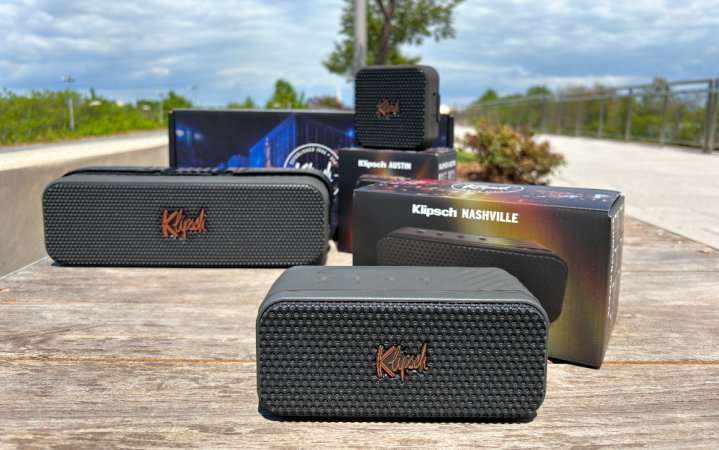We may earn revenue from the products available on this page and participate in affiliate programs. Learn more ›
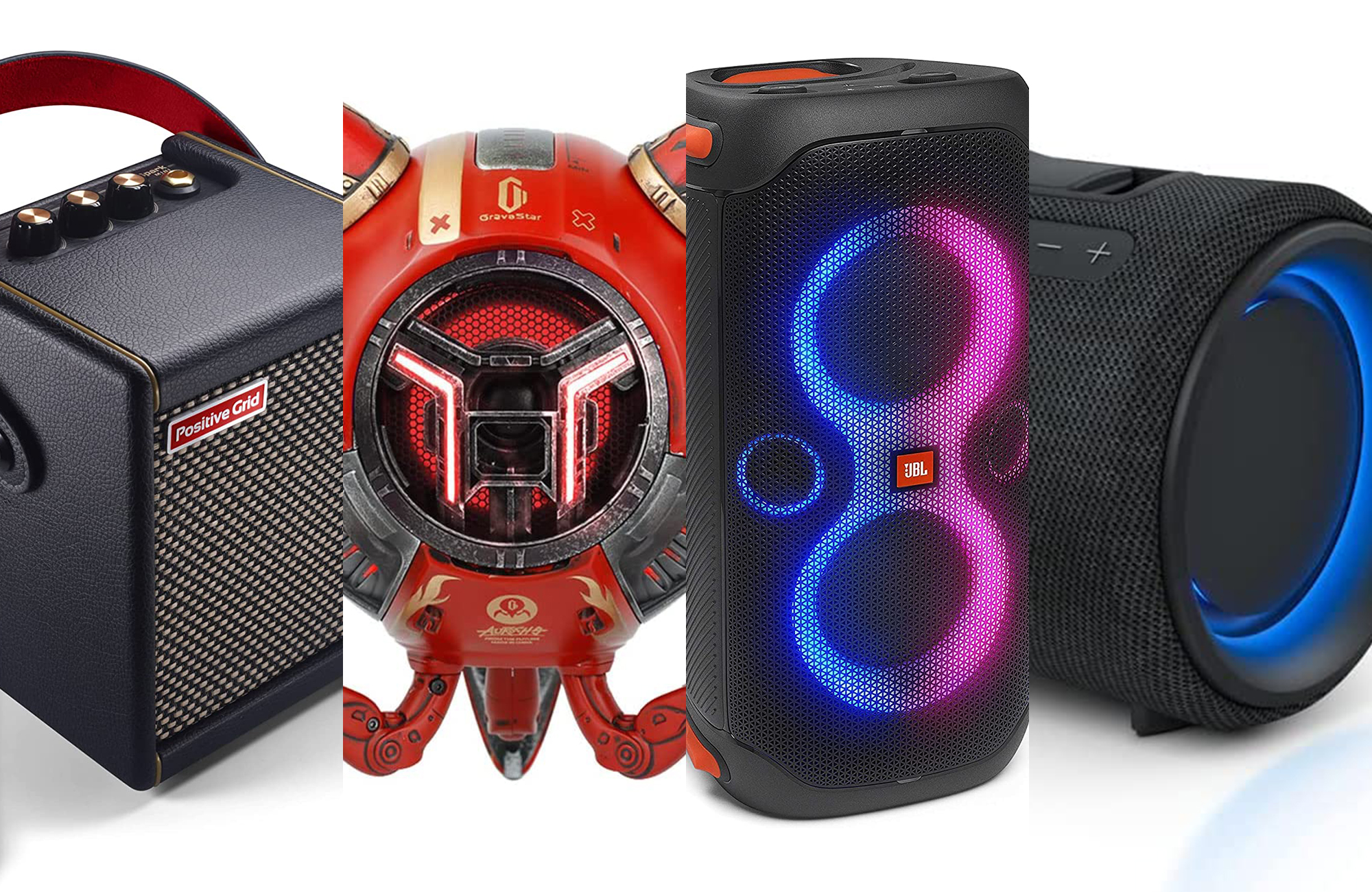
Party speakers may be the most misunderstood mainstream category in the audio world. Contrary to popular belief, party speakers aren’t limited to bass-heavy Bluetooth models. Of course, there’s nothing wrong with bassy Bluetooth speakers. Don’t worry, we’re going to recommend you some how-low-can-you-go options. However, a party speaker, to us at least, can be an all-in-one PA system, a practice amp that doubles as a speaker, a speaker that lights up the room just with dance music, or that adds in equally kinetic LEDs. The best party speakers can be a concert for one or for everyone, and they can be found in selections for every type of celebration.
- Best overall: JBL Boombox 3
- Best portable: Sony SRS-XG300
- Best with lights: JBL PartyBox 110
- Best for outdoor party: Rocksteady Stadium Travel Combo
- Best for house party performances: JBL EON ONE Compact Personal PA
- Best for guitarists: Positive Grid Spark MINI
- Best for gamers: GravaStar Mars Pro
- Best Wi-Fi speaker: Sonos Move 2
- Best budget: Tribit XSound Mega
- Best ultra-portable: LG Xboom Go XG2T
How we chose the best party speakers
This speaker category is extremely broad, so we took a fairly granular approach when choosing our recommendations. A mix of hands-on testing and research lead us to a list of speakers that range from pint-sized to powerful, covering common and niche needs. Special attention was paid to bass performance, connectivity options, durability, expandability, and portability. The right party speaker for you will depend on whether you’re throwing backyard cookouts or basement ragers, are looking for something that sits on a desk or a deck, need something to provide a solo gaming soundtrack or that might require guests to wear earplugs. We don’t judge. Well, we do judge some things, like audio quality and connectivity. But parties aren’t the time for critical listening, so what we recommend by the pool or for a DJ is very different than what we’d look for in our best powered speakers or best bookshelf speakers for music lovers. We’ve also been mindful of how much these speakers cost, with recommendations ranging from under $60 to $530.
The best party speakers: Reviews & Recommendations
We’ve cut through the noise to present speakers to suit everybody’s needs. You saw our overall methodology above and can find more information on our key considerations later in this story. Now, let’s get the party started.
Best overall: JBL Boombox 3
Pros
- Massive bass driver
- Can be connected with up to 99 other JBL speakers
- Excellent battery life
Cons
- Big and heavy for a portable speaker
Specs
- Bass driver size: 8.6 inches
- Power source: Battery power (up to 24 hours)
- Expandable: Yes
- Connectivity options: Bluetooth
- IP rating: IP67
JBL’s Boombox 3 pushes the limits of what you can expect from a portable Bluetooth speaker. The subwoofer in its three-way speaker configuration is larger than the ones you’ll find on some desktop speakers or compact monitors, so you should expect loud, thunderous sound. You won’t just hear the drop on EDM tracks, you’ll literally feel it radiate down to 40Hz if the speaker’s 160 watts are cranked all the way up. In fact, the only way you’ll get a louder, bigger bass around the same size is by picking up something like JBL’s PartyBox 110, which we’ll introduce in more detail below.
The Boombox 3’s large size comes with one big pro—beyond great sound, of course—and a necessary con. In the plus column, this speaker can last up to 24 hours on a single charge, easily enough time to get you through a proper rager. JBL says the amount of battery life you’ll get ultimately depends on your listening volume, which is true, but the Boombox 3 should still last all night (literally) even when it’s being maxed out. That said, a big battery and large drivers contribute to this speaker’s 22-inch width and nearly 15-pound weight. This speaker is portable, but it’ll need someone willing to lug it around—luckily, it’s equipped with a sturdy molded handle.
JBL has gotten around this by designing the Boombox 3 with support for its PartyBoost feature, which allows you to link it with up to 99 other JBL speakers. Several JBL speakers support this feature, so you could use the Boombox 3 as your main party speaker, then spread a couple of smaller models around the periphery of your party space to blanket more ground (for example, you could put several lava-lamp-like JBL Pulse 5 speakers around to visualize the vibe). We can’t think of a room—or entire floor, frankly—that this speaker wouldn’t blanket in loud sound on its own, however.
If your parties take place outdoors, the JBL Boombox 3 is a great choice thanks to its IP67 rating (for a detailed explanation of IP, check out our considerations at the bottom of this feature). This Boombox 3 can get splashed, rained on, spilled on, or even dunked underneath the water for several minutes without skipping a beat. And it can stand up to dust or sand. Durability is definitely not an issue. The speaker shown above has taken a licking and kept on kicking … or maybe that’s taken a kicking and kept on ticking, as it got hit by a soccer ball while providing the soundtrack to a high-intensity practice on the field pictured. If its size and weight (and $449 price) don’t intimidate you, the JBL Boombox 3’s bass performance, battery life, and durability are a pretty unbeatable combination.
Best portable: Sony SRS-XG300
Pros
- Mega Bass button for even more low-end
- Exceptional audio quality
- Best battery life for a portable party speaker
Cons
- Very few devices can take full advantage of this speaker’s audio potential
Specs
- Bass driver size: 2.7 inches (2x)
- Power source: Battery (up to 25 hours)
- Expandable: Yes
- Connectivity options: Bluetooth
- IP rating: IP67
Sony has been making party speakers for half a decade, but the SRS-XG300 is the first time it seems to take this category very seriously. It’s completely overhauled the look of its party speakers, with a mesh covering that screams sophistication, with LED rings that surround its pair of 2.7-inch bass drivers with a subtle glow rather than a garish one. And the unobtrusive handle conveniently slides in and out of the top, an aesthetically pleasing marriage of form and function. Put simply, the SRS-XG300 speaker looks sophisticated during the day but a little more fun at night. The LEDs can be turned off using Sony’s app or a button on the backside of this party speaker so you can ignore them entirely.
That may be a good idea if you plan on stretching the SRS-XG300’s battery to its 25-hour maximum. Sony is so confident in this portable Bluetooth speaker’s battery capacity that it built a USB-A port into it, so it doubles as a power bank. In our tests, this speaker could put out a tremendous amount of bass, but it never distorted, even at high volumes. If you want a little more oomph, the speaker’s Mega Bass button boosts low-end frequencies, but never to the point that the midrange and treble get completely drowned out. If your playlist is full of bass-heavy music, turning on this setting to see how you like it won’t hurt.
The SRS-XG300 supports a Sony feature called Party Connect, which allows you to pair up to 100 speakers to play music simultaneously. This was one of our favorite features of JBL’s Boombox 3, and it remains impressive here. We can’t see any reason you’d need more than one of these speakers to fuel your beach, backyard, or basement party, but it’s nice to have the option.
You can connect any smartphone, tablet, or computer to the SRS-XG300 wirelessly over Bluetooth, but to get the most out of it, you’ll need a device that supports the LDAC codec, which allows you to stream music at a very high—nearly CD quality—bitrate. This isn’t necessarily important at a party unless you host audiophiles exclusively. Still, it’s worth pointing out since Sony’s speaker is one of the few Bluetooth models that support this feature. But it’s also worth pointing out that only select digital audio players and smartphones support this protocol (nothing Apple, which is why we lean toward this being the best portable Bluetooth speaker for Android users). You can use any Bluetooth-enabled device to connect via more traditional lossy codecs, and you also have the option to connect a device using a 3.5mm cable, thanks to its AUX input.
If the most important part of your party is taking top-notch tunes conveniently from one place to another without hitting pause, Sony’s SRS-XG300 is the clear choice. Of course, you might want something even more pint-sized but still punchy. The ULT FIELD 1 is Sony’s latest entry-level Bluetooth speaker, and its audio quality and durability are both impressive, given its modest price. This is a mono speaker, but Sony has improved its audio fidelity by angling up its rectangular driver upward, so the sound is sent toward your head when it’s laid on its side. This makes a difference, as we could hear music more clearly during casual listening sessions at a desk. The other new audio feature is the inclusion of its “ULT” button, which enables deeper bass when pushed. And on the opposite end of the (frequency) spectrum, the ULT FIeld 7 is a hefty tank of battery power and bass that will turn heads when you hit play.
Best with lights: JBL PartyBox 110

Pros
- Massive
- Doubles as a dual-input PA system
- Can be used portably in a pinch
Cons
- Overkill in most cases
Specs
- Bass driver size: 5.25-inches (2x)
- Power source: Battery (up to 12 hours)
- Expandable: Yes
- Connectivity options: Bluetooth, AUX in, 1/4-inch inputs (2x)
- IP rating: IPX4
There’s no getting around the fact that the JBL PartyBox 110 is a big party speaker, but if you have enough space and need to entertain a large crew with live music or a pre-made mix, it’s the ideal choice. You can read more about this large speaker in our full review, but it’s ultimately a treat for both the eyes and ears. The PartyBox 110 occupies an interesting place in JBL’s party speaker lineup, sitting between our approved entry-level PartyBox, the Encore Essential, and the much larger PartyBox 1000 (a behemoth of a speaker we’ve auditioned and enjoyed). It’s also much more than a typical Bluetooth speaker, party-friendly or otherwise.
The big LEDs surrounding the PartyBox 110’s pair of bass drivers turn the front of this speaker into a big figure eight. These lights can be programmed to a handful of patterns—including synced to the beat—or turned off entirely to preserve battery life. Yes, despite the amount of air it’s pushing and the show it bestows, the PartyBox 110 can run for up to 12 hours without being plugged into an outlet. It’s also one of the only speakers in its size class to have an IP4X rating, which means it can be splashed with water without incident.
It may not support JBL’s PartyBoost, but two of these speakers can be paired together wirelessly. This makes sense when you realize the PartyBox 110 has a pair of 1/4-inch audio inputs designed for a microphone and instrument. Connecting these speakers together will double the number of inputs, giving you greater flexibility when setting up some competitive karaoke.
If you only plan on using this speaker with prerecorded music, you’ll be treated to loud, room-shaking sound at the highest volume levels. PA-style party speakers are known for their bass performance, but JBL built a Bass Boost button onto the top of the PartyBox 110 to really drive the point home for lovers of lower frequencies. Let’s face it: The PartyBox 110 isn’t necessary for the average cocktail party or even cookout, but having the extra power in your back pocket won’t hurt if it becomes necessary.
Willing to pay more for the latest and greatest? You can take everything to the next level … any level, really, with the built-in wheels and telescopic handle … if you pick up the PartyBox 320. This 38 lbs., 240W, 27-inch-tall loudspeaker can fill more spaces and melt more faces, and it has an even more expressive figure-eight of dancing LEDs. Plus, you can establish an Auracast Bluetooth connection to let it play the same song simultaneously on multiple current-gen. JBL party speakers, such as the Xtreme 4 next to the PartyBox 320 in the picture below.

Best for outdoor patio party: Rocksteady Stadium Travel Combo
Pros
- Modular assignable-channel speaker system
- Discrete dedicated subwoofer
- Unlimited speakers can be connected
- Portability
Cons
- You have to keep track of/charge multiple speakers
Specs
- Bass driver size: 5.1-inches
- Power source: Battery (Up to 16 hours)
- Expandable: Yes
- Connectivity options: Bluetooth, 2.5mm
- IP rating: N/A
By now, most people are familiar with a 2.1 speaker system in a home theater environment, which indicates Left and Right speakers paired with a dedicated subwoofer to push the lows higher. Now, the Rocksteady Stadium Travel Combo lets you take it into the great outdoors. All three touch-controlled speakers connect to one another via a Bluetooth 5.0 mesh network, which means you can place them anywhere you’d like so long as they’re within 100 feet of one another. This will allow you to cover a larger area without turning the volume knob to 11. Pick up four 6-inch-tall multidriver rectangles and turn your patio into a quadraphonic quarter. There’s a mid-bass driver and passive radiator paired with the tweeter in each. Still, for the deepest bass experience, you’ll want to keep the discrete front-firing subwoofer (or subwoofers) near a wall so the sound gets reinforced by reverberations.
Many party speakers we recommend can be chained to play simultaneously in mono, but Rocksteady designed its hardware exclusively to be immersive—letting you assign each as Left/Right/Dual channel. Because of that, you can pair an unlimited number of speakers in various multidirectional configurations, though hitting this theoretical limit—or lack thereof—probably won’t be necessary. We like the modularity of the Stadium Mode system, but it isn’t waterproof, which can be a problem if your outdoor area has a pool. If that’s the case, a cadre of UE WONDERBOOM 4 mini-speakers may be a better pick; these $99 floatable orbs produce surprisingly loud 360-degree sound, can be linked via PartyBoost and, being dustproof, are also one of the best speakers to take with you to the beach.
The only real downside to getting a multispeaker system is that you’ll need to monitor multiple pieces of audio hardware at all times. Every speaker needs to be charged separately, which can require some juggling if your place doesn’t have too many outlets. Luckily, battery life is rated at 16 hours, and the speakers are USB-C Quick Charge equipped. If that isn’t an issue, we can recommend taking Rocksteady’s Stadium Travel Combo to any outdoor party you’re hosting or attending.
Best for house party performances: JBL EON ONE Compact Personal PA
Pros
- Simple setup
- Easy-to-use controls
- Portable
- On-unit 4-channel mixer with EQ and effects
- Built-in microphone preamps
- Phantom power
Cons
- Can be too quiet for loud practices
- Reverb effect is subtle for those looking for washed-out sound
Specs
- Bass driver size: 8-inch woofer
- Power source: Battery (Up to 12 hours)
- Expandable: Yes
- Connectivity options: Bluetooth, AUX in, 1/4-inch input, mic/line input (2x)
- IP rating: N/A
The JBL EON ONE Compact Personal PA offers musicians and DJs an easy-to-setup audio solution for smaller performance situations. Weighing just under 18 pounds, packing a 12-hour swappable rechargeable battery, the speaker is light enough to carry to and from smaller gigs and fits easily in the trunk or backseat of most cars.
The onboard 4-channel mixer offers two XLR/TRS combo jacks, one 1/4-inch guitar input, and a 1/8-inch aux input for dialing in the mix. If you’re using a condenser microphone, the unit also comes equipped with phantom power. The EON ONE Compact Personal PA’s four-channel configuration provides the flexibility to create a balanced mix of guitars, vocals, and backing tracks from the controls on the speaker itself or via the JBL app. Connect your phone via Bluetooth to access Lexicon and dbx-inspired 4-band EQ, reverb, chorus, and delay (with quick-recall presets), plus control the volume or stream music wirelessly.
The unit can sit vertically or horizontally and provides a built-in pole mount socket for elevated placements. This flexibility allows the system to thrive in various settings, as a monitor or for broadcast, even when space is tight. Two USB 3.0 ports let you high-speed charge tablets, phones, and bus-powered DJ devices—perfect if you mix digital formats. According to JBL, a 1/4-inch (6.3mm) passthrough lets you connect up to four speakers and extend your mix to larger crowds. [We only got one speaker, so we couldn’t try this out.]
The EON ONE Compact can reach 112 dB, and the 8-inch bass driver hits 37.5 Hz, though it isn’t ideal for louder rock shows. However, it is a great option for solo and acoustic gigs and smaller gatherings where you want a bigger sound without a big hassle.
Best for guitarists: Positive Grid Spark MINI
Pros
- Ultra-portable guitar amp
- Ability to switch between 10,000 tones
- Smart Jam Live mode
Cons
- Only worthwhile for musicians
Specs
- Bass driver size: 2-inches (2x)
- Power source: Battery (Up to 8 hours)
- Expandable: No
- Connectivity options: Bluetooth, AUX input, 1/4-inch input
- IP rating: N/A
The Positive Grid Spark MINI was designed for musicians who don’t just want to attend a party; they want to amp up the entertainment at a party. However, its support for Bluetooth and the presence of an AUX input allow you to kick out other people’s jams too. As a 3.3-pound practice amp, the Spark MINI is surprisingly capable. Battery-powered and DSP-based, it has a single 1/4-inch input to plug in almost any electric instrument with a standard cable and get a far more robust tone than you might expect looking at the compact cube. You can add accompaniment (drums and bass) by pairing the speaker to your phone to play a backing track (or use your phone to learn with the Positive Grid app’s auto chords feature). Knobs on top of the Spark MINI let you independently adjust the volume of your music and that amazing new electric guitar you just picked up till you get the right mix (though the MINI plays nicely with acoustic guitar and bass, as well). You can even select your tone from an online library of over 10,000 sculpted through Positive Grid’s BIAS tone engine and shared through its app. It’s like carrying a Marshall stack or AMPEG cabinet … in a backpack.
Suppose you’re a solo musician going to a small get-together. In that case, the Positive Grid Spark MINI is way more practical to lug around than the other PA-capable party speaker we recommend. And with its 8-hour battery life, it will satisfy all but the most out-there jam-band fans. With just two 2-inch drivers and a passive radiator, it won’t earn the party speaker seal of approval as just a Bluetooth speaker, but it’s nice to have a near-field option if you’re in a small space with a handful of friends. Just avoid water (or a spilled beer) with this one. However, none of these downsides are dealbreakers because the Spark MINI is capable of its main task. One of this party speaker’s underrated features is its Line Out, which allows you to connect the amp to a larger PA. If you like a specific guitar tone from Positive Grid’s library and show up to a party with a larger system, you can use your preferred effects with a lot of additional volume.
When you’re not entertaining guests, you can connect this amp directly to your computer using its USB-C port and use it as an interface to record your instrument with your own custom guitar tone using the PreSonus Studio One digital audio workstation software that comes with it. Everybody likes going to a party with live music, but bringing all the equipment necessary for it at the last minute is not always practical. With the Positive Grid Spark MINI, it’s possible to fit everything you need for a “gig” in the back seat of a small car, making it a lot more reasonable.
Willing to trade a little space for more physical tone controls and more room-filling sound? The “full-sized” 40W Positive Grid Spark is still plenty portable, whether you’re ascending a stairway to heaven, speeding down a highway to hell, or taking friends and family on any other number of musical detours.
Best for gamers: GravaStar Mars Pro
Pros
- Intricate design
- Stereo pairing support
- Two subwoofers
Cons
- Limited connectivity options
Specs
- Bass driver size: 2.76 inches (2x)
- Power source: Battery (Up to 15 hours)
- Expandable: Yes
- Connectivity options: Bluetooth
- IP rating: IPX7
GravaStar’s Mars Pro proves there ain’t no party like a LAN party. OK, most of our competitive gaming is done remotely, but we like listening to big beats and bouncy bands with our big broadband. This 7.5-inch-tall wireless party speaker is relatively small but has multiple drivers, a big bass radiator, and 25W to deliver lots of low-end. Its distinctive, futuristic look will fit into a party hosted in a game room or bring an out-of-this-world vibe anywhere with a rechargeable battery that lasts 15-20 hours. That’s doubly true if you put a pair next to one another and connect them to listen in true stereo. Still, you must applaud the industrial engineering in this speaker’s zinc alloy body. There are multiple designs and colorways, a touch-responsive volume strip, and it even has LED accents all over it that would make it eye-catching on a livestream as you blast competitors and tunes.
As far as features go, you can’t plug an instrument into it or connect it to dozens of speakers simultaneously (just the one other for true L/R channels). Still, none of those options are absolutely necessary. If anything, pairing them down allowed GravaStar to focus more on audio quality and aesthetics, including making the Mars Pro IPX7—or effectively waterproof. Our only disappointment is that the only way to connect devices to this speaker is over Bluetooth 5.0. To be fair, that’s the universal wireless connectivity standard for all of the best portable speakers. However, it would have been nice to see an AUX in jack as a backup, especially with something that sits nicely next to a computer.
If that doesn’t bother you, the GravaStar Mars Pro is an excellent party speaker for smaller rooms. If anything, your guests may spend a few seconds searching around for the sound source when you start to play music from what they might have thought was an extremely detailed model. That party trick alone may make the Mars Pro worth the price of admission.
Best Wi-Fi speaker: Sonos Move 2
Pros
- Sonos’ ecosystem is strong
- Excellent range
- Amazon Alexa and Sonos Assistant compatible
Cons
- Price
Specs
- Bass driver size: 3.5-inches
- Power source: Battery (Up to 24 hours)
- Expandable: Yes
- Connectivity options: Wi-Fi, AirPlay 2, Bluetooth
- IP rating: IP65
The Sonos Move 2 comes hot on the heels of the Era 100 and Era 300, Sonos’ next-generation connected speakers, and inherits many of the same great traits. One of the Move 2’s biggest selling points is its Wi-Fi connectivity, which has two distinct advantages over Bluetooth: Longer range and the ability to stream higher-resolution music files. If you have the option to be on the same Wi-Fi network as the Move 2, that’s the connectivity option we recommend.
The Move 2 isn’t Sonos’ only portable speaker, but the diminutive Roam is too small to be used as a party speaker—especially given its price. The Move 2 is a lot larger, but the extra volume allowed Sonos to use better audio hardware. Sonos’ advancements in amp and driver technology shine through, as does the company’s tasteful use of EQ. Music never sounded too bassy or treble forward, it was, cliche as it sounds, just right. The Move 2 also supports TruePlay, a feature that allows it to automatically adjust its sound using its built-in microphone to determine the size and shape of the room it’s in.
This is the only party speaker we recommend in this roundup that supports Amazon Alexa, as well as the Sonos Assistant, allowing you to use it hands-free. Sonos allows you to link streaming services through its app, so you can call up playlists or make them up on the fly without touching your phone. This feature requires an active Wi-Fi connection, so consider that if you plan on bringing the Move 2 to a beach. On a related note, this speaker has an IP56 rating, so it can get splashed with water without incident, but don’t submerge it under water.
The Sonos Move s is an excellent portable wireless speaker for all occasions, but its bigger size and louder sound do make it especially useful for a party. The Move 2’s batter is also 13 hours longer than the first-generation, so it’ll keep the party going all night long. Taking a Sonos speaker by the pool or beach is extremely appealing. Our only concern with recommending the Sonos Move 2 is its $450 price, which is steep.
If you’re happy with the way Sonos speakers sound, the Move 2 is absolutely worthwhile, and it’s the best option if you’re looking for a party speaker with a Wi-Fi connection. Only planning to have people gather inside and want to fill an entire room with multidirectional music from one standalone speaker? The new Era 300 has an original acoustic design optimized for Dolby Atmos and the captivating gradients of spatial audio.
Best budget: Tribit XSound Mega
Pros
- Ultra-portable, with an included shoulder strap
- Battery lasts a long time relative to its size
- Price
Cons
- Smaller speakers make less sound
Specs
- Bass driver size: 1.5-inches (2x)
- Power source: Battery: (Up to 20 hours)
- Expandable: No
- Connectivity options: Bluetooth
- IP rating: IPX7
If you’ve spent your party budget on a venue, food, and drinks, there’s still bound to be enough in the bank for Tribit’s XSound Mega. The beach-bag-friendly speaker has two 1.5-inch bass drivers, which will pump out a reasonable amount of sound, given their size. If you’re hosting a small gathering at home or outdoors, it’ll be sufficient, but don’t expect miracles at a big backyard bash.
We named this the top party pick in our guide to the best budget Bluetooth speakers because of its battery life, multiple listening modes, built-in LEDs, and carrying strap. The fact that Tribit equipped it with a USB-A port, which allows you to use it as a power bank, was a welcome feature. We found the speaker’s XBass mode added an appreciable amount of low-frequency response but found the XSound Mega distorted a little at high volumes. It never ruined the song, but the distortion was present. Alternatively, the speaker’s LEDs were surprisingly sophisticated, pulsing rhythmically as the music played.
The Tribit XSound Mega is a little barebones compared to some of our other recommendations, but it also costs under $100. You’re getting a lot of value for your money with this party speaker, which has several of the same core features as our other recommendations in a smaller, less expensive package.
Best ultra-portable: LG Xboom Go XG2T
Pros
- Integrated flexible cord makes it easy to attach to just about anything
- 10 hours of battery is solid for a speaker of this size
- Relatively affordable
Cons
- Smaller size limits overall output
- Requires LG proprietary app for full control
Specs
- Power source: Battery: Up to 10 hours
- Expandable: No
- Connectivity options: Bluetooth
- IP rating: IPX67
Most portable speakers have a simple handle that makes them easy to carry around. However, LG’s pint-sized party speaker has an integrated cord that wraps around the speaker so it can easily attach to just about anything. Wrap it around a backpack strap, a fence post, or pretty much anything else that’s not much bigger around than your wrist. The speaker itself isn’t built for massive output. It only costs $80 retail, and it’s about the size of a peanut butter sandwich (or any other kind of sandwich—it’s lunchtime, and I’m thinking about peanut butter jelly time). A large knob on the side controls the volume, and a pair of raised buttons on the front make it easy to operate even when you’re not looking at it.
The built-in battery offers up to 10 hours of continuous playback, which is impressive for a speaker this size. It claims a rugged build, but it backs up its promise with an IP67 rating, which means it’s fully waterproof and resistant to impacts, dusts, dogs, spilled drinks, and just about anything else that typically ruins a speaker. The sound boost mode makes things louder, but it also drains the battery more quickly. It’s easy to stick in a bag, but the integrated cord also makes it easy to attach to a backpack without the need for a carabiner. For the price, it’s a lot of speaker in a very small package.
Also worth considering: Klipsch Nashville, Klipsch Detroit & Klipsch Austin
Klipsch’s Nashville is the mid-sized option in the company’s “Music City” portable speaker series, and it delivers a lot for its small size. The speaker has a pair of 2.25-inch full-range drivers behind its signature copper logo and black grille—one front and one rear-firing so it can be enjoyed from any angle. This Klipsch speaker’s drivers are augmented by a pair of bass radiators for cleaner low-end response. There aren’t any onboard tone controls, but you can tweak how the Nashville sounds using the Klipsch Connect app on iOS and Android if you’d like to dial in different frequencies or adjust its EQ to suit the type of music you like listening to the most.
Of course, none of this is worth a dang if the speaker ain’t got that twang. Luckily, the Nashville’s 60Hz to 20kHz frequency response is surprisingly robust for a speaker its size. At 50 to 60 percent volume, the speaker maintains pleasingly throaty dynamics with minimal distortion, thanks to its DSP. In addition, the Nashville supports Bluetooth 5.3, the latest, most stable version of the wireless audio protocol that allows for a feature called “Broadcast Mode” to use the SBC codec to connect up to 10 other Klipsch speakers, such as the $299 Detroit speaker (the elongated speaker in the image above) with a bass-reflex enclosure featuring two 3-inch full-range drivers, two 1-inch horn-loaded tweeters, and four 3-inch force-cancelling passive radiators for a frequency response of 55Hz to 20kHz. There’s also the ultra-portable, highly affordable Austin (the cube at the back of the picture), a compact square with a 2-inch woofer and separate tweeter and 10W 70Hz to 20kHz playback.
What to consider when shopping for the best party speakers
Bass driver
Party music is typically all about that bass—though midrange and treble shouldn’t be dismissed!—so it makes sense to focus on a party speaker’s woofer, the driver that determines how low (in the frequency range) you can go. The bigger the woofer, the more sound it can produce. The biggest impediment to bass performance is often size of the speaker itself, since a driver can only be as big as the case it’s in—though custom waveguides and well-implemented DSP can produce some surprising results. To ensure you get more bounce to the ounce, however, we’ve only chosen party speakers with larger bass drivers for this reason.
Power source
Some party speakers need to be connected to an outlet at all times because they consume too much power to run on a battery for a long period of time—if at all. The tradeoff between a smaller, less powerful party speaker and a large, high-powered one is real, but in many cases, the answer is clear. If you host large basement parties where there’s no chance of disturbing the neighbors, a plugged-in party speaker makes sense. For smaller get-togethers—especially those in the outdoors—a portable party speaker makes more sense.
Expandability
Some speaker makers allow you to daisy chain multiple speakers together, so you can play the same music in different places or listen in true stereo. In some cases, this feature is literally called PartyBoost mode. If the parties you throw take place indoors and outdoors, or you have to cover a lot of ground and don’t want a single huge speaker, expandability is key.
Connectivity
All of the party speakers we’re recommending support Bluetooth, the universal wireless standard that allows you to connect your phone, tablet, or computer to countless tech accessories. But even a universal standard has variants, so you’ll want to make sure the Bluetooth version of your source and speaker are in line (Bluetooth 5.3 devices are the most current, but there are plenty of 4.x devices floating around that still function perfectly well). Some have the option of connecting to your device over Wi-Fi, which offers a better range, a more stable signal, and higher-fidelity streaming. If you want to go old school, a 3.5mm AUX input will let you connect your source to the party speaker directly, which offers the highest level of fidelity—assuming you’re playing lossless music—but means your device is literally tethered to the speaker.
IP rating
A speaker’s IP (Ingress Protection) rating determines its durability against dust and water. Our recommendations range from having no IP rating to an IPX7 rating, which means they can be fully submerged underwater for up to 30 minutes without the risk of damage. This feature won’t matter if you keep your speaker indoors—so long as nobody spills a drink on it—but is extremely important if you host outdoor gatherings.
FAQs
Yes. A 500-watt speaker is powerful enough to play music at a volume suitable for indoor and outdoor parties. In many cases, a 30-watt speaker will be sufficient if you’re hosting a party on a single floor of a house.
Active—also known as powered—speakers are better for parties because they have an amplifier built into them. This design feature makes them more portable, which is helpful when hosting a party. Passive speakers are an okay choice if you’ve hooked up outdoor speakers connected to an amplifier in your home.
No. Some party speakers have a built-in microphone, but it’s not a requirement.
If you host many high-energy events or value features other than purely listening to music, a party speaker is worth it. If you’re just looking for a solo-session listening station, however, you can consider everything from traditional stereo speakers to the Sonos Era 300 smart speaker for spatial audio.
This depends on the speaker’s size, audio components, and additional features. Our lowest-cost recommendation costs $60, but you can pay upwards of $600.
Final thoughts on choosing the best party speakers
- Best overall: JBL Boombox 3
- Best portable: Sony SRS-XG300
- Best with lights: JBL PartyBox 110
- Best for outdoor party: Rocksteady Stadium Travel Combo
- Best for house party performances: JBL EON ONE Compact Personal PA
- Best for guitarists: Positive Grid Spark MINI
- Best for gamers: GravaStar Mars Pro
- Best Wi-Fi speaker: Sonos Move 2
- Best budget: Tribit XSound Mega
- Best ultra-portable: LG Xboom Go XG2T
Whether you throw a couple of casual get-togethers yearly or host the weekly event friends look forward to throughout the week, having a party speaker is key to everyone having a good time. No party is complete without music; you can be the hero by providing it. We’re especially pleased that companies have begun taking this speaker style seriously rather than chalking it up as a gimmick and slapping unnecessary features onto previously available models that just blurt farty bass. Any of our speaker recommendations will get the job done; now it’s your task to create the perfect playlist.
